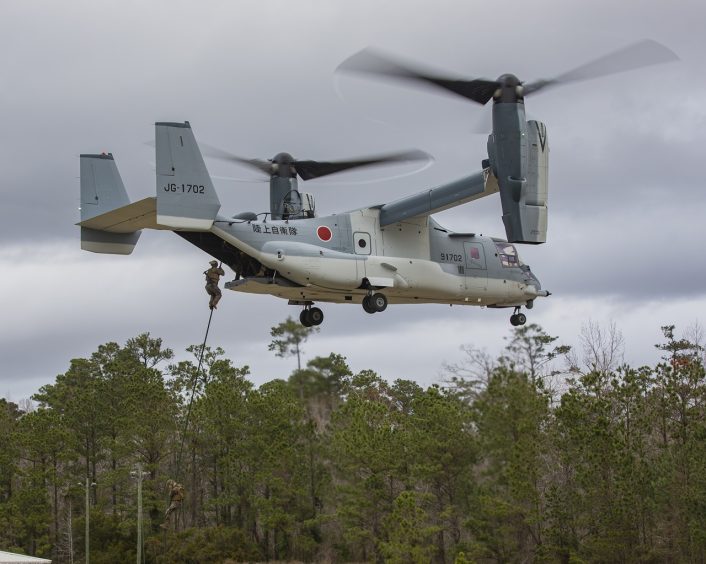The V-22 was taking part in a MEDEVAC/CASEVAC scenario as part of exercise Keen Sword. It lost balance and swung from side to side when it attempted to take off from Camp Yonaguni, resulting in the left engine’s nacelle striking the ground.
Within days of an investigation revealing deficient manufacturing and negligent quality control in V-22 Ospreys, a video emerged of an Osprey of the JGSDF (Japan Ground Self-Defense Force), the only foreign operator of the aircraft, in what is described as a “failed take off” at the service’s Yonaguni Garrison in Okinawa on the morning of Oct. 27, 2024.
This incident, the first involving a Japanese Osprey, happened during the ongoing Keen Sword exercise. The JGSDF operates a total of 17 Ospreys, with the 1st Helicopter Wing at Kisarazu Garrison announcing on Jul. 12 the delivery of the final tiltrotors.
A A GSDF V-22 #Osprey was damaged during takeoff at Yonaguni Garrison on Oct 27. The left wing struck the ground, prompting an emergency landing. All 16 Japanese and U.S. personnel onboard were uninjured. Flights are suspended pending investigation by the Ministry of Defense. pic.twitter.com/aAHmG24dns
— Eli Zusman (@muki46) October 28, 2024
While none of the 16 people aboard (including U.S. Marine Corps personnel) were injured, Japanese reports said military authorities have now grounded the Ospreys. However, Stars and Stripes quoted a statement it received from U.S. Forces Japan, saying that its own Ospreys “remain mission capable” and will continue to participate in Keen Sword.
The video of the incident, posted by Eli Zusman on X, showed the aircraft from beyond a perimeter fence, hovering with the rotors turned up, but heavily tilting to its left, or “shaking left to right” as a statement mentioned. The visibly unstable condition caused the left engine nacelle to “make contact with the ground,” said the officials, prompting an emergency landing. The Japan MoD suspended the V-22 flights, pending an investigation.
The aircraft’s final touchdown could not be seen because of a raised embankment between the fence and the runway, but the video nevertheless show the violent roll of the wings to the left side, when that part almost disappears under the fencing and the right rotor near completely tilts up, instead of the straight vertical descent it is supposed to have.
The mishap
NHK News said that the aircraft suffered “partial damage” in a “failed take off” at Yonaguni, located in the Okinawa Prefecture. The report quoted a statement from the MoD: “The aircraft lost balance and swung from side to side when it attempted to take off from Camp Yonaguni on the westernmost Japanese island of Yonaguni at around 11:40 a.m. on Sunday. The air outlet opening of the airplane’s left engine came into contact with the ground. It caused damage around the opening.”
The Osprey was participating in a module simulating MEDEVAC/CASEVAC scenarios. The report, in fact, mentioned “it was supposed to take off from the camp on a training mission to transport people with injuries.”
The USFJ statement to Stars and Stripes further added: “We do not anticipate any significant impacts to training. The U.S. remains committed to conducting realistic training exercises with our Allies and partners.” Japan’s Joint Staff spokesperson said they have grounded their 17 Ospreys, while Defense Minister General Nakatami said in a press conference that the service Ospreys will however carry out “mission flights.” “If a natural disaster occurs, we will decide whether to use the Ospreys or not, but basically, we won’t fly them,” he said.

The Osprey’s accident and resumption of flights
The Aviationist has been closely following the Osprey’s operations since the crash of a U.S. Air Force CV-22B Osprey on Nov. 29, 2023, off the coast of Japan, after it took off from MCAS (Marine Corps Air Station) Iwakuni. Eight personnel lost their lives in the mishap.
This Osprey, callsign Gundam 22, was assigned to the 21st Special Operations Squadron, 353rd Special Operations Wing at Yokota Air Base. The accident prompted a three-month safety stand down of about 400 Osprey tiltrotors in the U.S. Air Force, U.S. Navy, U.S. Marine Corps and the JGSDF fleet.
こんにちは!輸送航空隊です。
10月5日、木更津駐屯地において「第50回木更津航空祭・創立56周年記念行事」が行われ、一般公開されました。8機のV-22が滑走路上を地上滑走する「エレファント・ウォーク」 🐘💨を披露しました。当日は生憎の天候のなか、ご来場頂きありがとうございました! pic.twitter.com/jNWEpj9gXc— 第1ヘリコプター団/木更津駐屯地 (@1st_helb) October 10, 2024
Investigators pointed to the gearbox as the cause in their preliminary findings of that crash, and were further probing the reasons behind its failure. Previous incidents with the Osprey were attributed to a recurring “hard clutch” engagement. Subsequent findings in the Air Force’s internal SIB (Safety Investigation Board) identified the failed gear to have been manufactured by Universal Stainless, and an independent investigation by Hunterbook further found callous production processes at Universal Stainless for the specialty steel alloys that made up the gear.
Following the crash, Japanese and U.S. military authorities in March announced a “phased” and gradual resumption of flights with “restricted” flight envelopes and new maintenance and piloting procedures. The resumption first began with Japanese reports saying a JGSDF V-22 Osprey arrived at Kisarazu on Jun. 5.
The Osprey then began figuring frequently in exercises, with a U.S. Marine Corps MV-22B landing on the Turkish amphibious assault carrier TCG Anadolu and JGSDF CV-22 landing on the Japanese helicopter carrier JS Izumo. This suggested that the aircraft were being allowed to fly beyond their restrictions of 30-minute durations and only around a suitable airfield to return to in case of emergencies.

